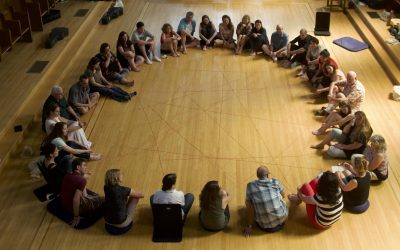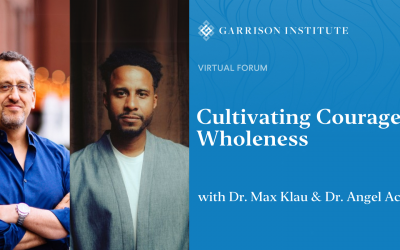Join John Tarrant at “Imagine a Doorway: The Creative Life and Meditation,” on September 16-18. Click here for info and to register.
Every creature alive has an interest in getting out of the cage, prison, or golden palace where their idea of themselves was formed and meditation is essentially an escape art. My earliest memories are of learning how to walk in the backyard in a foster home and staring at the vast fence palings and looking for a way through. I’m still always looking for a new idea or wondering how to get rid of an old idea that threatens to possess me. When the mind is involved, the quest for escape has a special feature: The situation I can’t fix is on my side. Here is an example that begins with the weather, something you can’t do much about.
This summer, which is winter in the southern hemisphere, a great 100 year flood came to Launceston, Tasmania, the town where I grew up. Up in the mountains, the waters gathered and they came roaring down the rivers bearing uptorn trees, lapping against high bridges and overwhelming low lying streets. The spiders escaped by spinning balloons, parachutes that loft and lift them up and away. Then something amazing appeared in the trees on higher ground—sheets and waves of silk, gossamer acres of shining silk.
I grew up with stories of the previous great flood, which was in 1929. In those days my mother lived by the port at the Marine Board where her father was eventually to become Harbour Master. That winter it rained prodigiously and kept raining, 13 inches in one night in the mountains of the northeast. A dam broke. And one day there was a sign that everything might be changing: the wharf rats came out along the esplanade in more or less single file, up the street to higher ground. They squeaked, plodded, hurried, and jostled shoulder to shoulder, hungry and soaked, and they came on and on through the grey, persistent rain. It was an astounding sight.
Unlike the rats, my grandmother did not evacuate but waited for her husband to come home. The rising floodwaters trapped her and her two young girls in the old convict built brick house where she lived. After dark, my grandfather—the occupant of the last car across the bridge, which was awash—arrived and organized a rowboat. The women were evacuated from an upper storey window by lantern light in the middle of the night.
I have heard stories of prisoners or children who befriended rats, but rats and humans are usually on opposite sides. The floods changed that though. I could tell that my mother still sympathized with those shivering creatures with their slicked down fur and I felt their daring and loyalty as they fled together. The animals had confidence in the arrival of the flood before the humans did, but that is not really unusual.
The disturbance and excitement comes in the discovery that things might not be as we thought, that the elegance of strangeness might be available at other times and in our ordinary lives. Some moments shimmer as if they will always be here.
My mind thinks its thoughts without consulting me and a surprise makes a kind of space in this process. A surprise is a shift toward some sort of waking up, a release from the prison of expected conclusions.
If I’m looking for an idea or wondering what life is about and how it all goes together, the answer isn’t likely to come from something known since that is where I would have already looked. It is more likely to come from nothing or from something humble or repulsive, from a place I wouldn’t think to look. The mind is always reaching past itself, to soothe itself, to be comfortable, smoothing over the disturbing, creative element.
This is the reason I work with koans. Koans depend on the unexpected and the uncertain, on opening a space in the expected. This is why Zen conversations don’t unfold in a predictable way. Here’s a Q & A from a koan set in China.
A student asked a teacher, “What is your state of mind?”
The teacher answered,
“Clasping their young to their breasts,
the monkeys return beyond the purple mountains,
holding with flowers in their beaks,
the birds alight before the blue grotto.”
The question is along the lines of “What is it like to be you?” and it has been asked of a Zen teacher, someone who might have something to say about consciousness. The answer has a bearing on how we can be creative and happy, on the nature of mind and the tidal pull of sorrow and all that. Instead of explaining something, the teacher just gives a few lines of poetry, an image of the unfolding of a bright moment.
The haiku poet Issa wrote,
Little girl
You’ll never teach that cat to dance—
Spring rain.
The thing that opens everything up is already present but overlooked, before you even leave the house.
A friend whose husband was dying wrote:
Orange blossoms and cinnamon rolls
will not save me.
Even the act of describing loss has its beauty. A snatch of a poem, a snatch of a koan, a moment of sorrow, a moment of amusement about a child, all of these moments have an everlasting quality.
The question “What is it like to be you”’ is also ultimately asking “What is it like to be me?”
All of our questions are directed to the ways the world surprises us and even more to the ways in which we surprise ourselves in our responses. And that’s probably enough for a creative life. The splendid thing is to be able to amaze ourselves, to be able to inhabit the entirely ordinary lives we already have with a freedom we thought impossible.
The transparence and luminosity is inside the thickness of the events happening now: the thoughts, the weather, the drifting spiders, the wet rats. That’s the world of koan meditation.
John Tarrant is the author of Bring me the Rhinoceros & Other Zen Koans that will Save Your Life and The Light Inside the Dark: Zen, Soul & The Spiritual Life. He is a Zen Roshi with a PhD in Psychology who, after 15 years of teaching koans in the classical Japanese way, developed new ways to teach people with no experience of Zen or even of meditation. He teaches meditation as a creative path.



